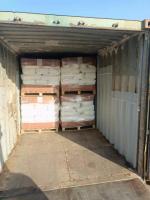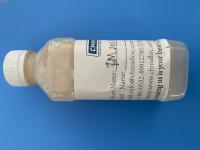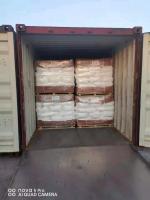Our Products
Polyacrylamide / Praestol 859 BS equivalent cationic polyacrylamide can be replaced by Chinafloc C9008

Praestol 859 BS is a high molecular weight, very high-charge cationic polyacrylamide emulsion developed for use in sludge dewatering, wastewater treatment, and solid-liquid separation processes. Manufactured originally by BASF (now part of Kurita), Praestol 859 BS is engineered for optimal performance in environments where high levels of suspended solids and negatively charged contaminants must be efficiently aggregated and separated from water.
Due to its high cationic charge (typically 50–60%), Praestol 859 BS exhibits strong electrostatic interactions with anionic particles, organic matter, and suspended solids found in municipal and industrial wastewater. Its high molecular weight promotes the formation of large, shear-resistant flocs, enhancing the efficiency of mechanical dewatering equipment such as centrifuges, belt filter presses, and chamber filter presses.
This article provides a comprehensive overview of the main applications of Praestol 859 BS, with particular emphasis on its role in municipal sludge dewatering, industrial wastewater treatment, chemical sludge processing, and related solid-liquid separation technologies.
1. Municipal Wastewater Treatment and Sludge Dewatering
A. Sludge Dewatering
The most significant and widespread application of Praestol 859 BS is in municipal wastewater treatment plants (WWTPs), specifically in the sludge dewatering stage. Sewage sludge contains large volumes of water—often up to 97%—which must be removed before disposal or incineration.
Praestol 859 BS, due to its very high cationic charge and strong bridging capability, is highly effective in conditioning the sludge to enhance water release. When added to sludge:
-
The polymer binds negatively charged solids, such as microbial cells and organic matter.
-
It creates strong, compact flocs that retain less water.
-
These flocs are easily handled by centrifuges, belt presses, or filter presses.
Benefits:
-
Higher cake dryness
-
Reduced sludge disposal costs
-
Improved dewatering equipment throughput
-
Lower energy consumption and chemical demand
Its use is particularly advantageous for waste activated sludge (WAS), which has a high biological content and is otherwise difficult to dewater effectively.
B. Thickening
In addition to dewatering, Praestol 859 BS is also used for sludge thickening, especially in gravity thickeners or DAF (dissolved air flotation) thickeners. The polymer enhances the sedimentation of suspended solids and increases sludge concentration, thereby reducing the volume of sludge that must be processed downstream.
2. Industrial Wastewater Treatment
Praestol 859 BS finds wide application in the treatment of industrial effluents, particularly from industries generating organic-rich or oily waste. These include:
-
Food and beverage production (meat processing, dairy, breweries)
-
Pharmaceutical and chemical manufacturing
-
Textile and dye industries
-
Pulp and paper processing
-
Petroleum and petrochemical facilities
A. DAF Systems
In dissolved air flotation (DAF) systems used in oily or greasy wastewater, Praestol 859 BS is dosed to:
-
Improve floc formation and floatation efficiency
-
Facilitate removal of fats, oils, and grease (FOG)
-
Enhance clarity of effluent water
Its high cationic charge makes it ideal for capturing and floating emulsified oils and suspended solids that may not settle effectively.
B. Coagulation and Flocculation Aid
In chemical wastewater treatment systems, Praestol 859 BS is used in conjunction with metallic coagulants (such as alum or ferric chloride) to:
-
Enhance charge neutralization
-
Promote faster settling
-
Improve turbidity reduction
It is especially effective in low-TSS, high-organic-load, or variable-pH wastewater, where high-charge polymers are required for stable floc formation.
3. Paper and Pulp Industry
In the pulp and paper sector, Praestol 859 BS plays an important role in both process water treatment and sludge dewatering.
A. Effluent Clarification
Effluent from paper mills often contains fine cellulosic fibers, fillers (kaolin, calcium carbonate), and residual organics. Praestol 859 BS helps:
-
Flocculate and settle suspended solids
-
Improve clarifier performance
-
Reduce chemical oxygen demand (COD) and biological oxygen demand (BOD)
B. Sludge Treatment
The primary and secondary sludge generated in papermaking processes can be effectively dewatered using Praestol 859 BS to:
-
Minimize disposal costs
-
Enable energy recovery via incineration or composting
-
Support zero-liquid-discharge (ZLD) strategies
4. Oil Refining and Petrochemical Wastewater Treatment
In refineries and petrochemical complexes, wastewater typically contains emulsified oils, hydrocarbons, and inorganic pollutants. Praestol 859 BS is used in:
-
Primary separation units to flocculate hydrocarbons
-
API separators and DAF units
-
Tertiary polishing stages to meet discharge limits
The high cationicity enables efficient capture of oil droplets, colloidal particles, and chemical emulsions, improving the overall quality of treated water and enabling recycling or discharge in compliance with environmental standards.
5. Chemical Sludge Conditioning
Chemical sludges, such as those generated from metal finishing, electroplating, or inorganic chemical production, are often dense and complex. The effectiveness of dewatering such sludge depends heavily on polymer performance.
Praestol 859 BS is particularly useful in treating sludges containing:
-
Heavy metals
-
Hydrated hydroxides
-
Oxides or precipitates
It helps in forming manageable, compact flocs, enabling:
-
Efficient handling
-
Lower transport volumes
-
Easier landfill or thermal treatment
6. Agricultural and Food Waste Treatment
In agro-industrial settings such as slaughterhouses, fruit/vegetable processing, and dairy farms, wastewater contains high organic loads and solids.
Praestol 859 BS is used to:
-
Reduce solids loading in biological treatment systems
-
Improve separation of manure solids
-
Enhance water recycling for non-potable reuse
Its strong flocculating action improves separation of fibrous and proteinaceous materials, optimizing both water quality and nutrient recovery.
Key Advantages of Praestol 859 BS
-
Very High Cationic Charge: Exceptional performance on biologically active and highly anionic sludges.
-
High Molecular Weight: Builds strong, shear-resistant flocs.
-
Versatile Application: Effective across a wide range of industries and wastewater characteristics.
-
Fast Reaction Time: Rapid floc formation enhances process efficiency.
-
Compatible with Most Dewatering Equipment: Performs well in centrifuges, belt presses, screw presses, and gravity tables.
Conclusion
The main application of Praestol 859 BS lies in its role as a high-efficiency sludge dewatering and wastewater treatment flocculant. Its high cationic charge and molecular weight make it exceptionally effective in aggregating fine particles, organic matter, and suspended solids in municipal, industrial, and chemical wastewater streams.
Whether it’s enhancing sludge cake dryness, improving flotation efficiency in DAF units, or treating oily or complex effluents, Praestol 859 BS consistently delivers improved solid-liquid separation performance. Its versatility across sectors—from municipal WWTPs and food factories to petrochemical and pulp mills—demonstrates its essential role in modern environmental and water resource management.





